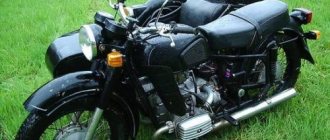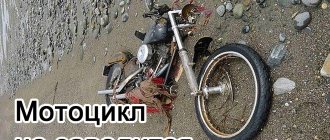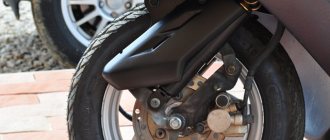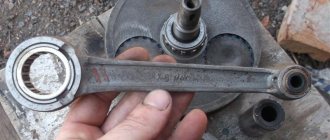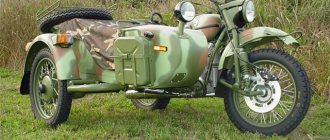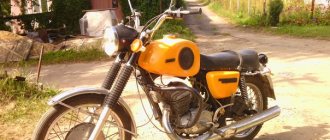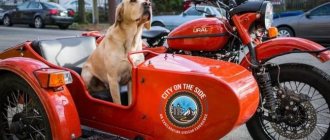What was a motorcycle with a sidecar like in its original form? This is a vehicle that consists of a two-wheeled motorcycle and a tightly attached stroller on one wheel.
Motorcycles with sidecars were previously very popular, because they were used as a cheap replacement for a passenger car. During the Soviet era, the most famous brands of motorcycles were “YAVA”, “IZH”, “URAL”, and “Dnepr” with a Velorex sidecar.
The appearance of the stroller
One day motorcyclists had a question: how to transport more cargo and more passengers? The first solutions were not very successful: a cart was attached to the front of the motorcycle, which meant that in the event of an accident, the passenger took the brunt of the impact; a cart was then attached to the back of the motorcycle - the passenger had to breathe in the motorcycle's exhaust fumes. Then, finally, a long-term solution was found: a stroller.
In the early days of motorsports, motorcycles with sidecars experienced a boom, but sidecars soon fell out of favor for both business and personal use.
"M-72"
It was produced in large series from 1941 to 1960 at factories in Moscow, Gorky, Irbit, Leningrad and Kyiv. Initially intended exclusively for military needs, the motorcycle did not go on sale until the mid-50s. Each M-72 carried small arms, so according to some classifications it was listed as an “armored vehicle.” More than 8,500 vehicles were produced. It was produced both with a stroller and in a single version. And the motorcycle was made on the basis of the German BMW R71 motorcycle. After the end of the war, vehicles fell into the ranks of the police, becoming the main transport of law enforcement officers. And since 1954, ordinary citizens could buy such “horses” for themselves.
The first strollers
In the United States, the first manufacturer of sidecar motorcycles was Thor in 1903. Unfortunately, the company closed after four years, like many other companies in those days. Harley-Davidson motorcycles were offered with sidecar mounts as early as 1905, but the sidecar did not appear in the company's catalogs until 1914, when a sidecar manufactured by the Rogers Company appeared. Perhaps most famously, Harley-Davidson completed an order in 1916 for a dozen sidecar motorcycles with machine guns mounted for General Pershing, who then used them at Pancho Villa, on the United States' southern border with Mexico.
Why does a cat ignore its owner when he calls him: two reasons for this behavior
Just look at their faces! It seems these dogs were people in a past life
When to spray the garden in spring: choosing the right weather
After this, wheelchairs were widely used by the military, often by medics or couriers, who could now move cargo faster between positions in the trenches of the First World War.
Motorcycle tires
Tricky topic. We all know that the right tires and wheels in general, along with the rim, size, and tread pattern can significantly affect the behavior of the motorcycle. In the case of sidecars, the issue of motorcycle tires concerns the rubber for the motorcycle itself and the trailer wheel. If you talk to the international association of sidecar motorcyclists, you can learn such an interesting thing as the practice of installing a car wheel. Follow the logic: if a motorcycle has a rigid sidecar mount, then it cannot turn the corners that a solo motorcycle does, which means it does not need round tires. In all seriousness, the association has motorcycles where car wheels are also installed because of the increased traction area. A car tire is wider, and with a smooth tread pattern the contact patch is larger. The idea is interesting, it is not relevant for everyone, but it has its place. Although it is still better to leave a round tire on the front wheel, because this will make it easier for you to maneuver at least the steering wheel. (“Motor tires - what’s the difference with a car tire?”)
Another trick: installing a larger front wheel so that it absorbs small vibrations from uneven roads and, accordingly, does not transmit this to the steering wheel. Again, these are special cases.
And lastly, much more common - tires on a motorcycle are wider than on a stroller wheel. The motorcycle should drive the trailer, which means it should resist less. With wide tires on a motorcycle, it has more ability to calm the cradle if it is on narrow tires. Its contact patch is reduced, and it reacts more easily. This is not the law everywhere, but it is not the exception to the rule.
The heyday of stroller use
After the war, the popularity of sidecar motorcycles declined slightly in the United States, but after some time they became popular again due to widespread commercial use. They were often used to help stranded motorists carrying gasoline and oil on the platform. In addition, companies often sent motorcyclists to clean up accident scenes. Surviving museum exhibits demonstrate the carriage's continued use for delivering candy, lumber, mail, milk, eggs and anything else that could fit in the carriage.
Small individual entrepreneurs were fascinated by the stroller. The Great Depression made most automobiles an unaffordable luxury, and the low cost of the sidecar greatly reduced the initial overhead costs of starting a business; its light weight and wide maneuverability made it easy to move around the city along delivery routes.
After the Great Depression, the sidecar saw widespread use in the military again during World War II. Due to the popularity of such transport during the war, returning soldiers loved the carriages and used them mainly for recreational purposes. However, around the same time, the stroller began to lose popularity among merchants.
In Norway they are going to build the first tunnel for ships in the rock
Mayan Ambassador's Tomb Reveals Rare Details of Mayan Officials' Lives
Volunteers from France will spend 40 days in a cave without electricity or smartphones
Steering Features
The first thing that catches your eye is the presence of a damper. (“Steering column damper, what's the point?”) Usually, that's all, but some go further. The essence of such innovations is that the steering wheel does not react to the behavior of the stroller and does not turn on its own, and is more predictable.
The presence or absence of a damper can be combined with tightening the steering bearings and adjusting the yoke. In other words, you make the steering wheel tighter. Yes, this will give you a powerful arm workout in the process and possibly rippled biceps, but either that or you'll have to catch the steering wheel more often.
Decline of the stroller
The real reason for the decline in popularity of sidecar motorcycles is quite obvious: falling car prices. As cars became equal in price or even cheaper than sidecar motorcycles, it became unprofitable for businesses to invest in a sidecar when a car, which was much safer and could be significantly modified, became more affordable. Without the sidecar being used commercially, as was the case during the interwar period, sales fell sharply. A family car trip meant greater travel safety for children and parents. Sidecars have lost their purpose as a means of transporting goods and have become too expensive for recreational use compared to motorcycles without sidecars.
Gradually they began to disappear. After Harley-Davidson adopted the swingarm suspension, sidecars became an absolute rarity on the motorcycle manufacturer's models, although some models were still found. The company stopped producing sidecars for civilian use entirely in 2011, although it still produces them for the Secret Service, which is why it's common to see several of these motorcycles in the motorcade of the President of the United States of America.
"L-300. "Red October"
This motorcycle was copied from the German DKW Luxus 300 in 1930. In the same year, the first models rolled off the assembly line. Although production ended in 1938, the history of the motorcycle did not stop there. The basis of the two-wheeled vehicle was taken for the design and production of the IZH-8 (which, by the way, is even depicted on silver coins of New Zealand).
Modern strollers
Self-contained sidecars are still available for purchase from several companies in the United States, but you'll have to make significant modifications to your motorcycle to accommodate such an addition.
There are, of course, many usable options, although the vast majority of them are now collector's items and well outside the average entry-level consumer price range.
Modernization
After some time, the K-750 model was modernized and became known as the K-750M. The difference was significant. The front wishbone fork was replaced with a telescopic, more modern one. A new gearbox with a closed-type foot shift mechanism was installed; the modernized driveshaft could be adjusted in length.
Further improvement of the motorcycle concerned the engine, the lower valve design of which did not allow increasing power by increasing the combustion chamber. The design of the engine was changed radically, the valves were moved to the top, the cylinder volume remained the same, and the engine power increased to 32 hp. With. Stable power was provided at 5200 rpm, which is a relatively low figure.
At the same time, the durability and reliability of the motor was increased. The prefabricated crankshaft was replaced with a solid cast one, the connecting rod roller bearings were replaced with Babbitt bearings from Moskvich-407. The service life of the crank assembly has increased to 40 thousand kilometers, and repairs have become much easier, since replacing the bearings with the next repair size is quite simple. During the engine modernization process, two oil scraper rings were added to the pistons. Later, the cylinder heads were replaced, the new ones became more finned, and the degree of cooling increased. The result is a powerful, efficient engine. The K-750 motorcycle has become faster and more maneuverable.
The speed of the motorcycle increased to 105 kilometers per hour. Fuel consumption decreased by 200 grams and amounted to 5.8 liters per hundred kilometers at a speed of 60 km/h. The efficiency of the engine has become stable and constant, thanks to the installed automatic ignition timing system.
Motorcycles "Ural"
If you're looking for a new motorcycle with sidecar, the only real option is Ural, a Russian motorcycle company. They have been producing motorcycles with sidecars since World War II, when the Soviet Union modified the BMW sidecar for use in the Red Army's winter war with Finland. Ural has been producing motorcycles for civilian use since the late 1950s, and modern versions strive to live up to their rugged origins, with the Ural Gear Up model designed for intensive off-road use.
While we may never see sidecar use as widespread as we did in the early 20th century, a motorcycle with sidecar on the modern road still evokes a sense of nostalgia, and riding in a sidecar makes you feel like you were in a motorcycle race in the first half of the 20th century.
Found a violation? Report content
1915 Harley-Davidson with the first original Harley sidecar. A curious machine - a motorcycle with a sidecar. Few of us rode in a stroller or in the back seat, and even fewer of us drove. But there are a small number of wheelchair enthusiasts who love their three-wheeled vehicles, sometimes called a sidecar or sidecar, and a significant number of companies that try to supply their products to their true connoisseurs. The origins of the sidecar are a matter of debate, but with the advent of the roller chain patent in 1880 and the advent of the popularity of the "safety" bicycle (with two equal-sized wheels driven by a chain at the rear), creative minds developed a very lightweight sidecar so that energetic young cyclists could transport their I'll give it style. When motors began to be installed on bicycles, the idea of carrying a passenger arose. In the Victorian era, you couldn't see a self-respecting woman in the back seat, not to mention the old back seats were terribly uncomfortable. The first mention I found of a motorcycle with sidecar was an 1893 competition set up by a French newspaper that promised a reward to the person who could come up with the best way to carry a passenger in comfort and elegance. Three very different methods were presented: from the front, from the back on a trailer, and from the side in a stroller.
Classic English crew. 1953 Ariel square four with Watsonial Squire sidecar Carrying a passenger in the front was a reverse tricycle, with two wheels and a passenger seat in the front and the driver sitting in the back. Anyone who had the pleasure of being in Saigon in 1960 probably drove one of these things with a sociopathic Viet Cong swashbuckler behind the wheel. The main problem was that the passenger literally “took the blow” in any collision. Rear trailer idea. A raised tongue that extends over the rear wheel and is attached to the motorcycle frame, usually under the seat. This two-wheel trailer could provide quite a lot of space, but the passenger would get all the noise and exhaust fumes, which was not popular among graceful ladies. The third and final option is a sidecar. The very first photo of a motorcycle with a sidecar that I saw was a Thor motorcycle with a sidecar, which the American company included in its catalog. The stroller was very presentable, made of wicker twigs. Which is good because of the light weight.
Five years later, motorcycle manufacturers began offering factory sidecars, and not only cradles, but also cargo bodies for delivery vehicles. A motorcycle and sidecar were cheaper compared to cars, and on bad American roads, stuck in the mud, they were easier to get out.
BMW P75 1943 as an example of a military motorcycle with a sidecar from the Second World War
Sidecar frames were fairly simple, usually tubular steel, with a sidecar or cargo container attached by bolts. In 1913, sidecar designers chose 2, 3, or 4 attachment points for the sidecar to the motorcycle. Two-point fastenings quickly disappeared, probably due to the fact that most strollers fell off on their own at speed. Most strollers did not have suspensions, but leaf springs were starting to appear. In 1913, Earl Johnson of Harlan, Iowa, patented a carriage with a sidecar wheel that could tilt with the motorcycle, anticipating the Flexi-Flyer (sidecar wheel tilts when the cradle is level) and Equa-Lean (the wheel sits in the center of the tilting cradle) designs.
The stroller itself could be single- or double-seater, cargo-carrying, with fire-fighting equipment, or a chimney sweeper. Harley Davidson was ready to tap into the stroller gold market. Their first catalog stroller appeared in 1914 and was actually made by Rogers. In 1915, Harley Davidson began making his own strollers. In 1916, the US Army ordered several Harley sidecars to fight Pancho Villa's troops in the deserts along the Mexican border, and Bill Harley designed a machine gun mount for the sidecar. During World War I, many motorcycles with sidecars were supplied to the Western Front, but they were used more as messengers and for transporting officers than for attacking enemy positions with machine gun fire. After the war, cars became quite inexpensive and there were fewer and fewer strollers. Trade continued to flourish with such firms as the English Watsonian (sold strollers since 1912), the German Steib (started in 1914) and the Australian-American Jim Goodling. They were very active, albeit limited. The Great Depression helped the industry a little because the motorcycle and sidecar were the cheapest means of transportation.
The third wheel is useful on a wet dirt road, Daytona Champion 2+2 sidecar After the Second World War, the American consumer society craved huge cars, and not motorcycles with sidecars. In Europe, low taxation on two- and three-wheelers and low car ownership have seen another flurry of interest in sidecars. However, by the late 1950s, thanks to cheap cars such as the British Ford Popular and the German VW Beetle, small cars again defeated sidecars. The industry collapsed, realizing that from a practical point of view, the motorcycle with sidecar had become useless. The only factories producing them as utilitarian vehicles were in the eastern bloc, such as the Czechoslovak Velorex in collaboration with Java, Ural and Dnepr in the Soviet Union [the author either knows nothing about Izh motorcycles with sidecars from the Vyatka-Polyansky plant, or does not consider them for motorcycles at all] and the Chinese. And Harley, of course, but more for ceremonial use. But enthusiasts breathed life into the legend. Californian Doug Bingham, also known as Mr. Side Strider Inc., began building and selling sidecar motorcycles in 1969. He established an annual wheelchair rally in Griffin Park in Los Angeles for decades before his death in 2016. A half-dozen other American companies, such as Champion and Motorvation, as well as Texas and California (made in Virginia), make strollers, with a long list of options and related products. No need to be afraid of falling on wet grass in the Urals with a sidecar. In Europe, there is a demand for specialized motorcycles with sidecars with complex suspension systems designed to improve handling, usually of a bulky design. I remember well the day when I was riding in the Alps and far ahead I saw a motorcycle with a sidecar. Just as I was thinking about catching up with him, he probably saw me in the rearview mirror and accelerated, and all I could do was hang on behind him. And only in heavy traffic was I able to catch up with him. It was a BMW K100 with a reclining stroller, with a wife and child in it. Now in this country there is only one company that sells motorcycles with sidecars: Russian Ural. And there are a dozen American companies that manufacture or import strollers, the purchase costs of which can vary greatly.
Ural worker Albert Menzi rides with his sidecar raised with his wife Ruth One final note: although sidecar motorcycles are in the collections of many automobile museums, there is only one museum that I know of that is dedicated only to the history of sidecar motorcycles, the Constantino International Sidecar Motorcycle Museum Frontalini near Cignoli in the Italian province of Marcelata. Check out the site, sidecar.it, and you won't be disappointed - knowledge of Italian will be helpful, although the pictures still need a little explanation.
Attaching the Sidecar If you're thinking about attaching a third wheel to your motorcycle, you'd better learn all about toe-in, camber, the offset of the sidecar wheel relative to the rear wheel of the motorcycle, and many other measurements. It is relatively easy to attach the stroller, but not easy to do it correctly. And if you do it wrong, you'll wonder why the damn thing runs so bad. In this country, the sidecar is attached to the right side of the motorcycle, allowing the driver to look ahead of the truck and see what is happening there. In England and other right-hand drive countries, the stroller is attached to the left. Poor English girl whose boyfriend wants to drive across the continent because now the stroller is on the wrong side, as far as the driver has to lean out to see what's behind the truck.
An equa-lean sidecar on a turn in Death Valley, California, 1983. The natural physics of motorcycle handling, including lean, are canceled out when the sidecar is attached. Unless, of course, you have a reclining stroller, but I don’t think any manufacturers make this system yet. I walked a thousand miles with an equa-lean stroller 20 years ago and loved it. But this is probably because at heart I am more of a motorcyclist than a wheelchair user. Once the third wheel is attached, the lean factor goes away and steering takes place by turning the front wheel. Therefore, a motorcycle with a sidecar handles more like a car than a motorcycle.
Buying or attaching a stroller Think seriously. Driving a motorcycle with a sidecar is completely different than driving alone. In fact, there is probably nothing at all in common. Wheelchair riders are generally warm and friendly, so I would wholeheartedly advise a beginner to try to find an experienced trainer in the area and listen carefully to their advice. The largest gathering of wheelchair users can be found through the American Wheelchair Association, which hosts annual meetings and publishes a bimonthly magazine, Sidecarist. You can contact her at sidecar.com Stay in touch and see if any class of wheelchairs is for sale in your area. I especially emphasize: you must receive the necessary instructions.
BMW with a Steib sidecar However, to the extent possible, I will be very grateful to you if you begin your training without drastic actions and do not overestimate your capabilities. The biggest problem is the “lifting” of the stroller, which can occur when driving in a right turn or curve. Simple physics explains that the sidecar will rise up, and the motorcycle will lean in the opposite direction of where the driver wants to turn. This is fun for an experienced wheelchair user and scary for a beginner and his passengers. In 1997, the USCA Sidecar safety program published a 120-page tome written primarily by wheelchair genius David Hogue called Sidecar Motorcycle Driving, 2nd Edition.
A motorcycle with a sidecar makes going out into nature more enjoyable
original article ridermagazine.com/2011/05/13/a-short-history-of-sidecars/
001_moto_1210_058
The team of the Irbit Motor Plant with special lightweight sports strollers, 1947.
The team of the Irbit Motor Plant with special lightweight sports strollers, 1947.
For the 1945 USSR Championship, Irbitsk residents entered five crews in the wheelchair class. The competition took place in the vicinity of Moscow at the 23rd kilometer of the Minsk Highway. The IMZ team from the first “batch” became the winner in the 300-kilometer linear race, where the Igor Okunev/Alexei Antropov crew achieved particular success. The Irbit duo set an All-Union record for covering 300 km on a specially prepared M-75. Okunev and Antropov covered this path in 2 hours 56 meters 9.9 seconds, improving the previous record by more than 30 minutes. In the cross-country, 2nd place was taken by the already well-known pair - Veniamin Gubin / Alexey Dubskikh on the M-72. Looking ahead, let's say that they will also become champions and prize-winners of the USSR and the RSFSR.
005_moto_1210_058
For winter cross-country racing, a ski was sometimes used instead of a stroller wheel.
For winter cross-country racing, a ski was sometimes used instead of a stroller wheel.
All kinds of new products were developed for sports in the department of the chief designer of the plant. Since 1952, they began to produce cross-country M-72Ks in small batches for the country's leading clubs. Considering that fording was an invariable component of motocrosses of that time, the air intake was placed in the upper part of the gas tank. Production of the M-72K lasted six years, and just over 300 motorcycles were produced. Having received such a device, the racers themselves “brought it to mind” - they installed a friction shock absorber on the spark plug suspension of the rear wheel, installed a hydraulic damper, etc.
008_moto_1210_058
The overhead valve M-61K was produced from 1959 to 1965.
The overhead valve M-61K was produced from 1959 to 1965.
By the early 60s, Irbit had become one of the country's recognized leaders in motorsports in the wheelchair class. Therefore, it is no coincidence that in 1962 he was entrusted with holding the Union motocross championship. In those years, the tracks underwent radical changes - they were no longer hundred-kilometer “mud” roads, but spectator-friendly loop tracks (2–4 km in length) with a set of natural obstacles. For the factory team at IMZ they developed and manufactured a new motorcycle, the Cross-650. A high-speed 40-horsepower engine spinning up to 6,000 rpm, a rear swingarm and a weight reduced by 15 kg made the car modern and fast. The seat was also removed from the stroller—there was no time for the wheelchair user to rest on the new route.
Technical characteristics of motorcycles K-750 and K-750M
They are as follows:
- number of seats - in the two-wheeled version 2 seats, with a stroller - 3 seats;
- Dimensions in the two-wheel version: length 2430, height 825, width 1100 mm;
- with a stroller - width 1700 mm, track 1200 mm;
- wheelbase - 1450 mm;
- engine - opposed, carburetor, gasoline, two-cylinder, four-stroke;
- cylinder diameter - 78 mm;
- compression ratio - 6;
- piston stroke - 78 mm;
- crankshaft rotation speed - 4600-4800 rpm;
- working total cylinder volume - 746 cc/cm;
- power - 26 l. With.;
- total weight - 240 kg;
- maximum speed of the motorcycle is 90 km/h;
- fuel consumption - 6.0 liters per 100 kilometers;
- carburetor brand - K-37A;
- fuel tank capacity - 21 liters;
- ground clearance - 120 mm;
- maximum load - 300 kilograms.
The technical characteristics of motorcycles may have changed slightly during production.
011a_moto_1210_058
Serial motocross IMZ-8.201 - the plant produced such motorcycles until 1992!
Serial motocross IMZ-8.201 - the plant produced such motorcycles until 1992!
Alexander Bulanov is the director of the Irbit State Motorcycle Museum, master of sports in motocross, champion of Russia (1982), record holder of the Guinness Book of Records. In 1992, Alexander Bulanov and Anatoly Bekishev drove a Ural with a raised stroller 1014 km in 24 hours along the stadium treadmill. In 1993, Alexander Bulanov, Anatoly Bekishev, Konstantin Matveev drove 25,505 km non-stop in 440 hours in the Ural.
Irbit "strollers"
004_moto_1210_058
Sometimes the climbs had to be overcome “manually”...
Sometimes the climbs had to be overcome “manually”...
In Irbit, winter is long - snow lies from November to April. So winter racing is in order for Irbitsk residents. Often the tracks were laid along a “crossroads” with partial use of horse roads, on which, due to the limited width, only a motorcycle could fit, and the side trailer moved across the virgin soil. Therefore, instead of a wheel, a special metal ski was installed on the stroller.
010_moto_1210_058
The stroller helps the driver control the motorcycle, loading the rear of the stroller as much as possible.
The stroller helps the driver control the motorcycle, loading the rear of the stroller as much as possible.
Since 1977, they decided to hold the USSR Championship in two classes: “free up to 1000 cm³” and “national up to 650 cm³”. If the “1000” had no design restrictions, except for the ban on the use of components and parts produced in capitalist countries, then with the new “650” they did the incredible. Everyone was required to perform on mass-produced “cars” without any modifications, i.e. on M-63K. It was a step back. After all, by this time the leading racers of the country were already racing on motorcycles with a pendulum fork, a “Swedish” sidecar, reinforced reverse gear, with a close gearbox, with Czech carburetors... Why did they do this? This was determined by DOSAAF: let everyone compete in production cars under equal conditions. The results of the 1977 national championship in this class looked depressing. All the strongest racers retired for technical reasons, and the classification was given to crews with a soft, “walking” style of racing, without much overload of the engine and chassis, without much risk on the track, which is so necessary for victory.
018_moto_1210_058
In the “Swedish” stroller, the front part of the stroller is loaded and the rear wheel of the motorcycle is partially lightened.
In the “Swedish” stroller, the front part of the stroller is loaded and the rear wheel of the motorcycle is partially lightened.
The following year, there were relaxations in the 650 class. They allowed a “Swedish” sidecar, a pendulum fork, and a reinforced reverse gear, but they didn’t allow a closer gearbox. Some racers secretly circumvented such prohibitions. The lack of a serial gearbox was skillfully compensated for by replacing the standard “eight” rear gear (based on the number of teeth on the shank) with a “seven”. In the “1000” category, some craftsmen also circumvented the ban on using components from capital countries. For example, perfectly working Bilstein gas-filled shock absorbers were skillfully disguised as homemade products.
In the second half of the 80s, realizing that we were far behind Europe, sports officials lifted all restrictions. The 650 class was instantly transformed. The serial frame was replaced with a special, lightweight one (the author was one of the developers of such a frame and successfully defended his thesis on this topic at the Irbit Motorcycle College back in the early 80s). “Large travel” appeared for both the rear wheel and the stroller. And later - mono-suspension of the rear wheel with “progression”, disc brakes on both wheels, etc. The experimental workshop of the plant produced 10–20 such devices per year until the mid-90s. The dominance of the Irbitsk team in the “union” in the “650” class, starting in 1987, was undeniable in these cars, and only occasionally did representatives of other teams get on the podium.



